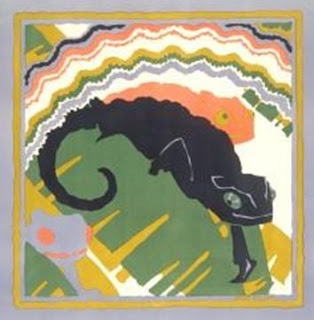British landscape painter and illustrator.
Jean’s father, Stanley Royle, was a respected British R.B.A. landscape painter and illustrator who exhibited at the Royal British Academy of whom I’ll show some nice paintings.  This wintery British Blues scene reminding me of Clive’s recent posting on Hiroshi Yoshida Blues)
This wintery British Blues scene reminding me of Clive’s recent posting on Hiroshi Yoshida Blues) In many of his paintings Royle talents as an illustrator is clear: they could easily be transferred into poster art.
In many of his paintings Royle talents as an illustrator is clear: they could easily be transferred into poster art. 




But the surprise was finding this pastel (1922) a composition of impressive trees (elms ?) and farmhouses set in a landscape. This composition will be recognized by every print enthousiast. I think. The subject (and even the background landscape) having great resemblance with Sylvan Boxsius (1978-1941) most famous print “Autumn”.
The subject (and even the background landscape) having great resemblance with Sylvan Boxsius (1978-1941) most famous print “Autumn”. There are two more similarly and impressively designed prints ( I know of) by Boxsius, one called “Pines” (R.) the other “at Winchelsea” (L.). The two obviously belonging together, Winchelsea is located near to the British Channel coast.
There are two more similarly and impressively designed prints ( I know of) by Boxsius, one called “Pines” (R.) the other “at Winchelsea” (L.). The two obviously belonging together, Winchelsea is located near to the British Channel coast.
Where the farmhouses in Boxsius’ “Autumn” print are located I don’t know. The Boxsius family was from London origin I believe (there was a furrier Boxsius in London’s Milton street 62 in the 1830’s). The Royle family originating and living in the Sheffield area and choosing his artistic subjects from the Derbyshire and Yorkshire countryside.
More on Jean and Stanly Royle here:
http://www.jean-royle.com/
http://www.stanley-royle.com/




 Jean Royle made these card designs in the 1980’s according to information from the website dedicated to the works of her and her father, (see below for the Link). I like them very much because of their “simple” but very strong composition.
Jean Royle made these card designs in the 1980’s according to information from the website dedicated to the works of her and her father, (see below for the Link). I like them very much because of their “simple” but very strong composition.



 This poppies and tree landscape designs are very much in the style of Dutch printer Arie Zonneveld’s (1905-1941) little landscape print half a century earlier.
This poppies and tree landscape designs are very much in the style of Dutch printer Arie Zonneveld’s (1905-1941) little landscape print half a century earlier.
























 Ridden with moisture (foxing), heavily stained and dirty. All of them. To this day I am not sure why. Maybe it has to do with coastal Portmeirion, Wales, England. All examples shown on the internet seem to have a local owners origin. But they look as if they’d been tucked away in the garden shed. For decades. How sad. How very sad.
Ridden with moisture (foxing), heavily stained and dirty. All of them. To this day I am not sure why. Maybe it has to do with coastal Portmeirion, Wales, England. All examples shown on the internet seem to have a local owners origin. But they look as if they’d been tucked away in the garden shed. For decades. How sad. How very sad.













